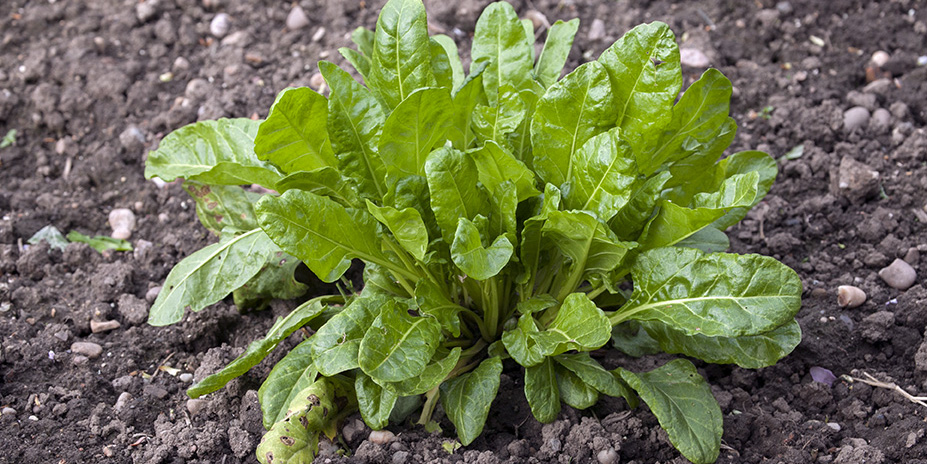Spinach
Leafy greens are all very nutritious and are said to play an important role in keeping the heart healthy and preventing cancer. Spinach is one of the best because it is packed full of various vitamins and minerals like potassium – it’s particularly good at combating diseases and age-related eye degeneration leading to blindness, and is prescribed for high blood pressure, anaemia and constipation.
Several very good reasons to grow it in your allotment and eat lots of this ‘superfood’ fresh when it is at its most nutritious. It loses much of its nutritional value with storage of more than a few days. Refrigeration can help retain most nutrients for up to eight days, but it will still lose most of its folate and carotenoid content.
Spinach is an annual plant but it will survive through the winter in mild areas and keep producing leaves into the following Spring . Another plus is that you don’t need to pull up the whole plant – with ‘Perpetual spinach’ you can just take off a few leaves from each plant for your meal and wait for it to produce new ones for next week. You can also blanch and freeze it if you have too much coming to maturity at once. Storage in the freezer can be for up to eight months.
Finally, you can eat it raw or cooked – the baby leaves or those at the top of the plant are good for salads and the bigger leaves for cooking.
Chard
(also known as Swiss chard, leaf beet, spinach beet and seakale beet)
You can grow chard as well as or instead of spinach and it’s quick and easy to grow. It is related to the sugar beet, and has large, tough leaves that taste a little like spinach, but slightly sweeter. Since starting to grow various types with white, yellow and red stems, we’ve not had a month go by when there hasn’t been some to pick. The more you pick, the more leaves pop up, and by the time it starts going to seed, your new crop is ready for harvest. What other vegetable gives such year round ‘service’! Probably the best months for harvesting are June to November
Like spinach, chard is full of vitamins and minerals, in particular Vitamins A, C and K, so it helps the body manage blood sugar and is anti inflammatory. It’s very perishable and is best eaten the day you pick it. To stop it wilting and keep it fresh for longer, stick the stems in a pot of water overnight, or store it in a perforated bag in the fridge for up to 4 days.
You can eat the small young leaves raw in salads, which is best for retaining its nutrients. Cooking the larger leaves should be brief to minimise loss of vitamins etc, but long enough to make them less bitter. The resulting flavour is more delicate than that of cooked spinach.
Cooking chard
The fleshy stems take longer to soften than the leaves, so cook these separately in order to minimise the cooking time for the leaves, or start with the stems, then add the leaves a minute or two later.
Preparation: wash then cut off the stems from the leaves and leave whole or chop, as required. On some older leaves you may need to cut the ribs out of the leaves, too. Leaves can be left whole, or chopped, as required, but don’t discard the larger more mature leaves – they are just as tender as the younger ones.
Cooking times
Stems: stir-fry about 2 minutes; boil – 3-4 minutes; steam – 4-5 minutes; roast -10 minutes.
Leaves: boil for 1-2 minutes; steam for 3-4 minutes.
Recipes
Chard with garlic
Cook with 2 tablespoons olive oil, bunch of chard, slices of garlic (1 clove), pinch of dried crushed red pepper flakes and ¼ teaspoon crushed coriander seeds (optional).
Wash the chard, tear or cut the stalks off and cut them into 1 inch pieces. Cut the leaves into 1 inch strips. Keep separate. Heat the oil in a sauté or deep frying pan and cook the garlic slices, pepper flakes and coriander seeds on a medium heat for about 30 seconds, then add the chard stalks, cover the pan and cook over a low heat for 3-4 minutes. Then add the leaf strips, turn them over in the garlicky oil and cook for a further 3-4 minutes, or until tender enough for your liking.
Chard Tzatziki
The Greek dip Tzatziki is usually made with cucumber. Why not try this one with chard?
Ingredients
100g chard, chopped
1 garlic clove
A pinch of salt
200g Greek style yogurt
1 tbsp olive oil
1 tablespoon lemon juice
A pinch of cayenne pepper
Freshly ground pepper
Pitta bread, for serving (optional)
Method
- Blanch the chopped chard for 2-4 mins. Plunge into ice cold water to stop it cooking. Drain and squeeze dry.
- Pound a peeled garlic clove with a pinch of salt. Mix with the yogurt.
- Swirl through 1 tbsp olive oil, 1 tbsp lemon juice and cayenne pepper to taste. Season.
- Serve with pitta bread.
Creamed spinach or chard soup with croutons
This smooth, creamy soup can be made in less than half an hour. To save even more time, the croutons can be made in advance and stored in an airtight container. Adding some of the leaves at the last minutes keeps the soup a lovely bright green.
Preparation time 10 mins Cooking time 40 mins Total time 50 mins Serves 4
Ingredients
- 1 litre chicken or veg stock
- 1 medium potato, peeled & diced
- 40g butter or 2 tbsp olive oil
- 1 garlic clove, crushed
- 400-500g spinach or chard, washed, & chopped.
- 200ml milk
- ½ tsp ground nutmeg
- Juice of ½ a lemon
To serve
- Half a ciabatta loaf, preferably stale, cut into small cubes. Other bread can be used.
- 15g Parmesan, grated (optional)
- 4 tbsp double cream or sour cream, to serve (optional)
- Salt & pepper
Method
- Bring the stock to a simmer and add the potatoes. Cook for 20 minutes or until the potato is soft.
- Meanwhile heat the butter or oil in a separate pan. Add the garlic, stir briefly and add the chopped spinach or chard. If using spinach, trim off the stalks before chopping. Chard stalks are fine. Cover and cook for a few minutes until the leaves are wilted.
- Add half the leaves and the milk into the stock pan and bring back to the boil. If using chard cook for a further 5 minutes. Put the soup through a sieve or colander to separate liquid and vegetables. Return the liquid to the pan. Add the reserved spinach or chard to the cooked vegetables and purée them in a blender or processor.
- Return blended vegetables to the stock and reheat. Season well. Add the nutmeg and lemon juice to taste.
- Make the croutons by gently frying the cubed bread in the olive oil until golden. For extra flavor, remove from pan, sprinkle with Parmesan and grill for a couple of minutes. Drain on kitchen paper.
- Serve the soup swirled with cream or soured cream, sprinkled with croutons.

